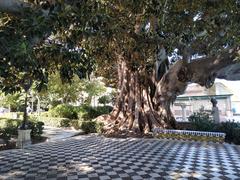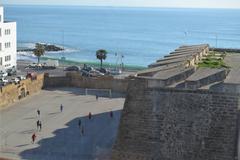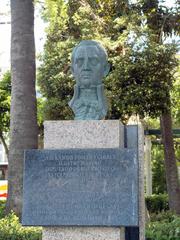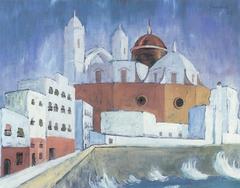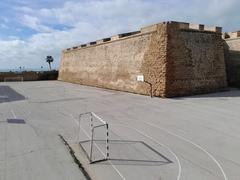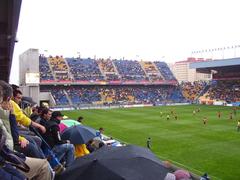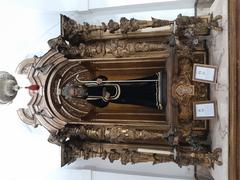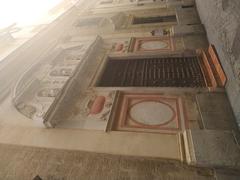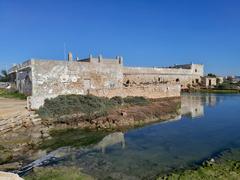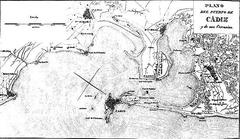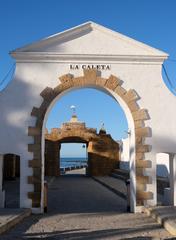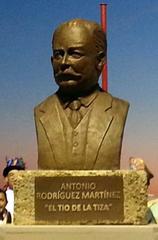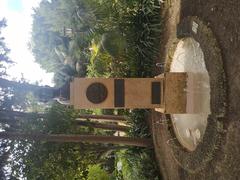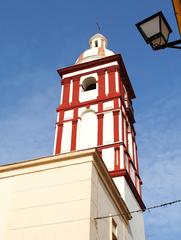Correos y Telégrafos Cádiz: Complete Guide to Visiting Hours, Tickets, and Historical Significance
Date: 14/06/2025
Introduction
The Correos y Telégrafos building in Cádiz stands as a striking symbol of Spain’s communication heritage, blending architectural grandeur with nearly three centuries of postal innovation. Situated in the lively Plaza de las Flores, this historic post office not only offers essential services but also invites visitors to explore its unique architecture, storied past, and central role in the evolution of Spanish society. Whether you are an architecture enthusiast, history buff, or traveler seeking a cultural experience in Cádiz, this comprehensive guide details everything you need to plan your visit, including hours, ticketing, accessibility, nearby attractions, and the building’s historical importance (PARES, Correos Official History).
Table of Contents
- Origins and Early Development of Correos y Telégrafos
- Institutionalization and Expansion
- The Emergence of the Cádiz Building
- Visiting the Cádiz Correos y Telégrafos
- Architectural Highlights
- Technological Innovation & Modernization
- Organizational Evolution & Public Mission
- Symbolism & Cultural Significance
- Visitor Tips & Practical Information
- Frequently Asked Questions
- Summary & Staying Up to Date
- References
Origins and Early Development of Correos y Telégrafos
Spain’s national postal service traces its foundational roots to the 16th century under Felipe I of Castilla, initially serving royal and governmental needs (PARES). The system underwent significant transformation after the War of Spanish Succession. King Felipe V institutionalized postal operations in 1716, appointing Juan Tomás de Goyeneche as Chief Superintendent, which marked the move from a royal concession to a centralized public institution (Correos Official History).
Institutionalization and Expansion
The 18th and 19th centuries saw major reforms and technological leaps:
- 1755: Rationalization of postal tariffs and creation of new services such as Lista, Apartados, Impresos, and Periódicos.
- 1756–1762: First urban postmen appointed and public mailboxes installed.
- 1777: The Real Ordenanza del Correo Marítimo established the Dirección General de Correos in Madrid, centralizing operations (PARES).
- 19th Century: Introduction of postage stamps (1850), creation of the Telegraph Corps (1855), and daily deliveries (1870) marked Spain’s alignment with modern postal standards. Women joined the workforce in 1882, reflecting broader social change (Correos Timeline).
The Emergence of the Cádiz Building
Cádiz, a historical port city, played a strategic role in Spain’s postal network. By the early 20th century, the city required a modern postal headquarters. In 1915, the municipality provided a prime site at Plaza de las Flores, and the new building was completed in 1929 (Diario de Cádiz). Designed by Modesto López Otero, the structure features four distinctive facades, a grand vestibule, and a luminous glass-roofed operations patio, epitomizing the eclectic regionalism of early 20th-century Spanish architecture (Arquitectura Contemporánea de Cádiz).
Visiting the Cádiz Correos y Telégrafos
Visiting Hours & Entry
- Monday to Friday: 08:30 – 20:30
- Saturday: 09:30 – 13:00
- Sunday: Closed
Entry is free; no tickets or reservations are needed (turismo.cadiz.es).
Accessibility
The building features step-free entry and wide doors, accommodating visitors with reduced mobility. Some interior areas may have limited accessibility, a common aspect of historic buildings (visitingcadiz.com).
Guided Tours & Events
Guided tours are occasionally organized during heritage events or local festivals. For schedules, check with the local tourism office or Correos announcements.
Nearby Attractions
Located in vibrant Plaza de las Flores, the post office is steps from:
- Cádiz Cathedral
- Mercado Central (Central Market)
- Historic Old Town
- Plaza de San Juan de Dios
The area is well-served by public transport and surrounded by cafés, tapas bars, and shops.
Architectural Highlights
The building is a five-story example of eclectic regionalism, with:
- Four free-standing facades and ceramic tile ornamentation
- A grand, double-height vestibule leading to a central glass-roofed patio
- Decorative brickwork and glazed ceramics that contrast with Cádiz’s traditional architecture (Arquitectura Contemporánea de Cádiz)
Tip: Capture the colorful façade and architectural details in your photos for a memorable keepsake (alt text suggestion: “Correos y Telégrafos Cádiz façade with decorative tilework”).
Technological Innovation & Modernization
Correos y Telégrafos has continually embraced innovation:
- Late 19th–20th Century: Urgent letters, money orders, and public telephone service (1884)
- 1981–1990: Introduction of postal codes and full computerization of the network
- 21st Century: Launch of digital platforms, automated parcel lockers (CityPaq), and eco-friendly delivery vehicles (Correos Timeline)
Organizational Evolution & Public Mission
Correos evolved from a royal institution to a modern, state-owned public company—Sociedad Estatal Correos y Telégrafos S.A., S.M.E.—in 2001 (PARES). Today, Correos is Spain’s designated Universal Postal Service operator, playing a key role in social and territorial cohesion (Correos Strategic Plan).
Symbolism & Cultural Significance
The Correos logo—with its crown and post horn—reflects royal origins and the traditional tools of postmen (Logos World). The Cádiz building, with its central location and unique style, is a living monument to the modernization and unity of Spain.
Visitor Tips & Practical Information
- Address: Plaza de las Flores, s/n, 11001 Cádiz, Spain (turismo.cadiz.es)
- Transport: Easily accessible by foot or public transport. Parking is limited in the historical center; use paid garages on the outskirts.
- Services: Full postal operations, insurance, money transfers, DGT paperwork, and Citypaq lockers (correos.es).
- Customer Service: English proficiency varies; consider using a translation app for complex requests.
- Etiquette: Take a queue number on arrival. Be mindful of crowds, especially during local festivals.
- Photography: Allowed outside and in public areas—respect staff and customer privacy inside.
Frequently Asked Questions
Q: What are the opening hours?
A: Monday–Friday 08:30–20:30; Saturday 09:30–13:00; closed Sunday.
Q: Is there an entry fee?
A: No, entry is free; no ticket required.
Q: Is the building accessible?
A: Step-free entry and wide doors, though some interior areas may be limited for wheelchairs.
Q: Are guided tours available?
A: Occasionally, during special events—check with local tourism offices.
Q: Where can I park?
A: Use paid garages on the outskirts; parking is scarce in the historic center.
Q: Can I take photos?
A: Yes, outside and in public areas; be discreet indoors.
Summary & Staying Up to Date
Correos y Telégrafos Cádiz is more than a working post office—it’s a vibrant living monument to Spanish communication history and a fine example of early 20th-century architecture. With free entry, extended hours, and a prime location amid Cádiz’s key attractions, it is an essential stop for cultural travelers. For the latest times, events, and accessibility updates, visit the Correos website, check Cádiz’s tourism portal, or download the Audiala app for interactive audio tours and real-time city tips.
References
- Exploring the Historic Correos y Telégrafos Building in Cádiz: Visiting Hours, Tickets, and Must-Know Tips (Correos Official History)
- Diario de Cádiz – Futura Casa Correos y Telégrafos (Diario de Cádiz)
- Arquitectura Contemporánea de Cádiz – Correos y Telégrafos (Arquitectura Contemporánea de Cádiz)
- PARES – Archivo Español de Administración (PARES)
- Turismo Cádiz – Plaza de las Flores y Edificio de Correos (turismo.cadiz.es)
- Visiting Cádiz – What to See and Do in Cádiz: A Comprehensive Guide (visitingcadiz.com)
- Correos Timeline and Strategic Plan (Correos Strategic Plan)
For further assistance, contact the office directly or consult the official Correos website.
Enhance your Cádiz experience with the Audiala app for interactive tours and real-time updates. Follow us on social media for the latest news and travel inspiration!
